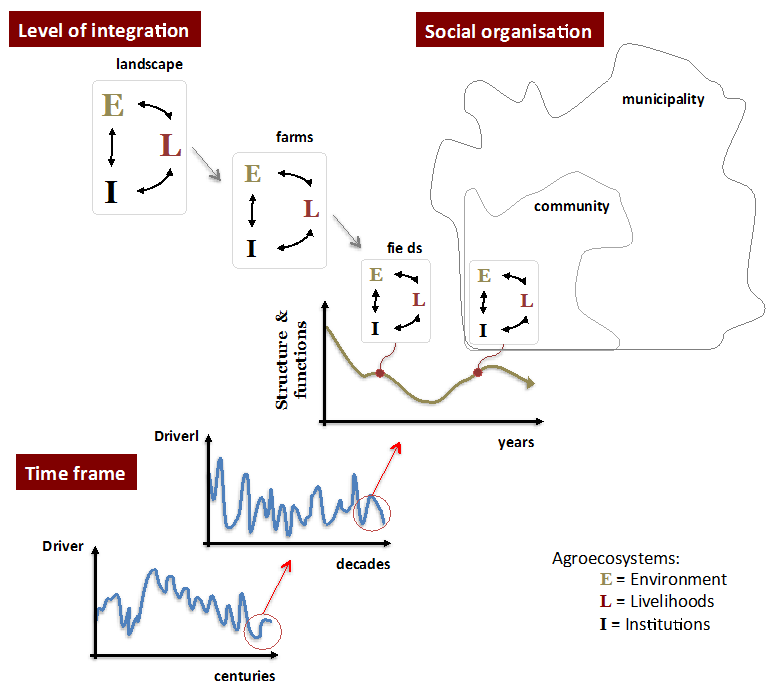
The farming systems decalogue: Trade-offs at different scales
 Farming communities re-shape the landscapes they depend on, with a potentially strong impact on the agro-ecosystem. Efforts to intensify cereal production must take account of the potential trade-offs, and the opportunities opened by an integrated systems approach. The ATTIC project proposes 10 principles for farm systems analysis.
Farming communities re-shape the landscapes they depend on, with a potentially strong impact on the agro-ecosystem. Efforts to intensify cereal production must take account of the potential trade-offs, and the opportunities opened by an integrated systems approach. The ATTIC project proposes 10 principles for farm systems analysis.
By Pablo Titonell, Professor of Farming Systems, Wageningen University
The Agro-ecosystem Diversity, Trajectories and Trade-Offs for Intensification of Cereal-based systems (ATTIC) project, a collaboration between MAIZE CRP and Wageningen University in the Netherlands, is studying the past and present trajectories of farming systems in three countries – Ethiopia, Mexico and, Nepal – to help research have a greater impact in the future through new technologies, practices and policies. A key dimension of the project studies the interactions between farming systems and the landscape, with farms both contributing to and benefiting from landscape features and services, including water flows, soils and biodiversity.
Societies value agricultural landscapes in different ways according to their culture, needs and perceptions. Rural communities shape their landscapes in response to resource-use priorities, but also due to demographic changes throughout their history. The resulting landscape patterns and organization have a strong influence on the functioning of the agro-ecosystem, particularly on the capacity of the remaining plant, animal and microorganism diversity to contribute the self-regulation of systems. This calls for innovative approaches that regard the agricultural landscape as supporting functional biodiversity to aid agricultural production, sustainable management of natural resources and wildlife and provision of ecological services (e.g. regulation of water dynamics and pest populations).
Trade-offs between these three sets of objectives are not uncommon. A number of modelling tools can explore alternative farm and landscape configurations and their properties through spatially explicit, multi-objective evolutionary algorithms. These tools lend themselves very effectively to the analysis of trade-offs and synergies between agriculture production and ecosystem services in interaction with stakeholders through co-innovation processes. A project addressing these trade-offs at system level is being implemented with MAIZE CRP in collaboration with the CIMMYT Global Conservation Agriculture Program and the Farming Systems Ecology Group of Wageningen University in the Netherlands. In the ATTIC project, we examine the effect of contextual drivers on how agro-ecosystems are structured and function in order to understand the relevant current and future trade-offs in ecological intensification across different scales.
 Trajectories of change in the structure and functioning of agro-ecosystems (encompassing their environmental, livelihood and institutional dimensions) are determined by the dynamics of contextual drivers and cross-scale interactions. The above example is illustrated for a field-to-landscape interaction, but is equally valid for higher scales (from Valbuena et al., 2013).
Trajectories of change in the structure and functioning of agro-ecosystems (encompassing their environmental, livelihood and institutional dimensions) are determined by the dynamics of contextual drivers and cross-scale interactions. The above example is illustrated for a field-to-landscape interaction, but is equally valid for higher scales (from Valbuena et al., 2013).
A good example of the need for integrated systems approaches is the design of pest-suppressive landscapes based on the dynamics of biological control agents. Landscape design for biological control requires fine-tuned ecological engineering in order to provide alternative sources of food and shelter for natural enemies distributed strategically in space and time (e.g. sources of nectar throughout the season), matching demand and supply (e.g. flower morphology to match the morphology of insect proboscis) and offering hibernation sites.
In Ethiopia, questions around the design of effective biological control for maize stem borers and understanding how communities manage their landscapes and assessing push-pull options for pest management in conservation agriculture schemes are being addressed as part of the Ph.D. thesis of Yodit Kebede. In Nepal, the Ph.D. thesis of Victoria Alomia combines system models, field experiments and participatory research to examine alternative forms of crop-livestock integration through intensification of maize and wheat production in association with fodder crops, as a form of diversifying diets and incomes. In Central Mexico, the Ph.D. thesis of Leendert van Wolfswinkel examines the trade-offs and synergies between alternative community land use and agricultural practices in water regulation services in maize-based systems (for example studying the potential of conservation agriculture to improve water regulation at micro-watershed level).
The examples mentioned above have a methodological backbone in common – they link participatory research, field measurements and experiments and system models at different scales. The specific methods will always vary according to the research question being addressed, but in general the various methodological steps can be summarized around 10 sets of principles that we call the Farming Systems Decalogue. Comprehensive methodological approaches to quantitative farming systems analysis should at the minimum include the necessary tools and concepts to:
I. Categorize and describe the diversity and dynamics of farming systems.
II. Categorize and describe their heterogeneity and variability in space and time.
III. Capture spatio-temporal patterns of factor allocation at farm scale.
IV. Quantify interactions between systems components (e.g., crop-livestock).
V. Involve actors and embrace lay knowledge systems.
VI. Scale up and down from single fields to multi–functional landscapes.
VII. Capture collective decisions and resource flows in communities/territories.
VIII. Analyze (quantify and map out) trade-offs within rural livelihood systems.
IX. Prospect farming futures and explore scenarios.
X. Inform effective targeting of agricultural innovations.
The order of these 10 sets is not rigid, the list may not be exhaustive, and the relative importance of each set of principles and methods depends on the objectives for which a farming systems analysis is carried out. They combine systems analysis theory, on-farm research and participatory approaches, multivariate statistics, use of geographic information systems and simulation modelling. It is clear that this type of work, which integrates disciplines as diverse as agronomy, animal husbandry, ecology, farm economics and rural sociology requires multi-disciplinary teams.
Africa, Ethiopia, farming systems, Mexico, modeling, Nepal, trajectories
